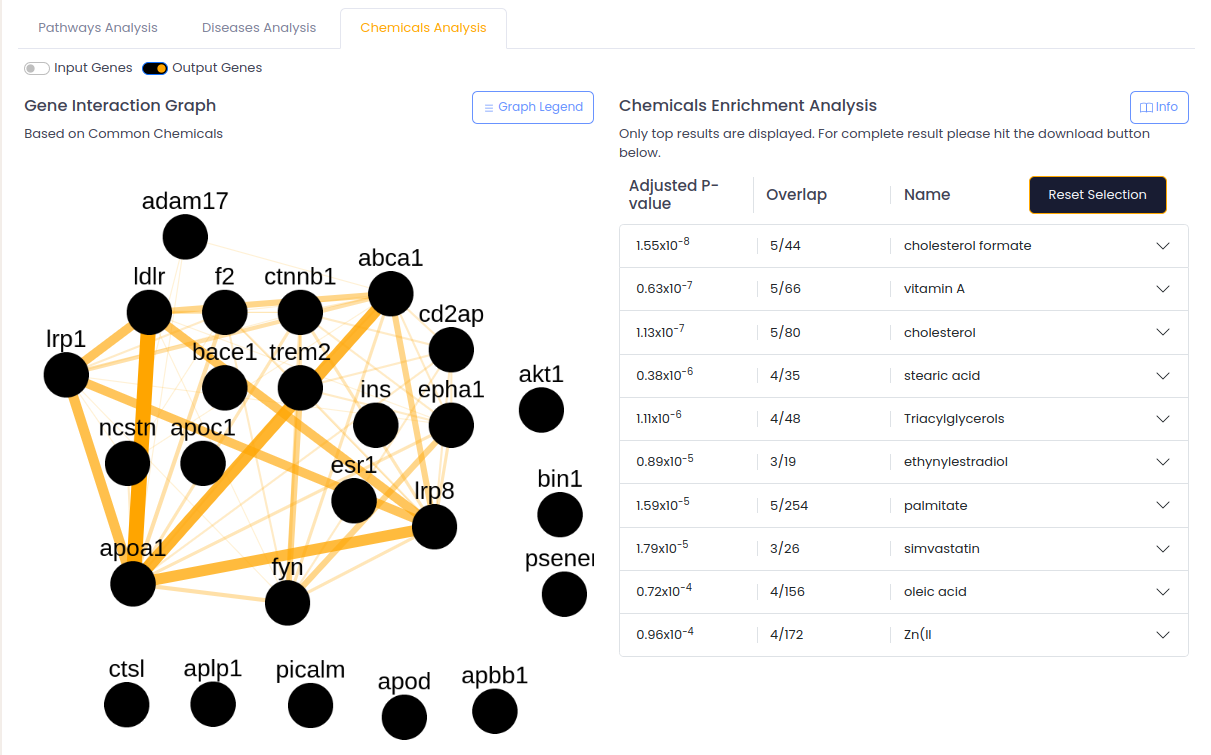Chemical enrichment
Alzheimer's disease, a Chemical Enrichment analysis
GeneRecommender offers the option to operate various types of enrichment analyses on gene sets, with the possibility to select only inputs, outputs, or both.
In the case study here presented it will be proposed the utilization of the system in a chemical enrichment task regarding Alzheimer’s disease.
Alzheimer’s disease is a progressive neurological disorder that affects a person’s cognitive abilities, particularly memory, thinking, and behavior. It is the most common cause of dementia, accounting for 60-80% of all cases.
The disease is caused by the buildup of amyloid plaques and tau tangles in the brain, which disrupt normal brain function and ultimately lead to the death of brain cells. Alzheimer’s disease typically begins with mild memory loss and other cognitive difficulties, and gradually worsens over time, eventually leading to significant impairment in daily life.
There is currently no cure for Alzheimer’s disease, and treatment options are limited.
The cause of Alzheimer’s disease is not fully understood, but risk factors include age, genetics, lifestyle factors, and certain medical conditions. Researchers are working to better understand the disease and develop new treatments and interventions to slow or prevent its progression.
The test was carried out by giving as inputs to the system the MESH tree code of Alzheimer’s disease and the genes related to the pathology according to the database Diseases of Novo Nordisk Foundation Center for Protein Research. Output genes were set at 25 and a Chemical enrichment was performed on them.
Enrichment analysis is a computational method used in the field of bioinformatics and systems biology to identify overrepresented biological terms or functions in a set of genes or proteins of interest.
Enrichment analysis helps to identify biological processes, molecular functions, and cellular components that are significantly associated with a particular set of genes or proteins. It involves comparing the set of genes or proteins of interest with a reference database, such as Gene Ontology (GO) or KEGG pathway database, to identify overrepresented biological terms or functions.
Among the output genes recommended, an example subset is: LDLR, LRP8, LRP1, CTNNB1, and APOA1.
Low-density lipoprotein receptor (LDLR) and its Related Proteins (LRP8, LRP1) seem to play a significant role in the etiopathology of Alzheimer’s disease according to recent scientific literature:
Also, catenin beta (CTNNB1), part of the protein complex that constitutes adherens junctions, can be related to Alzheimer’s disease through the Wnt/β-Catenin Pathway:
These findings confirm the relevance of the outputs of GeneRecommender, upon which the system performs the Chemical enrichment analyses considering molecules present in String database (https://string-db.org/) and their related genes.
The top results are shown in figure below:

In the second position, after sorting on adjusted p-value, is present Vitamin A. All the proteins codified by the 5 aforementioned genes are in some way affected by that molecule.
Vitamin A is an anti-oxidant compound and plays a role in maintaining higher function in the central nervous system. Exists evidence that plasma or cerebrospinal fluid concentrations of vitamin A and β-carotene tend to be lower in AD patients. According to K. Ono et al., Vitamin A (retinol, retinal and retinoic acid) and β-carotene have been shown in in vitro studies to inhibit the formation, extension and destabilizing effects of β-amyloid fibrils (https://pubmed.ncbi.nlm.nih.gov/22221326/).
Another compound highlighted from the Chemical enrichment is simvastatin, a drug used to lower high levels of cholesterol and other fats in the blood. It belongs to a class of drugs known as HMG-CoA reductase inhibitors, or statins. Simvastatin works by blocking the enzyme that produces cholesterol (another molecule enriched in the analyses) in the liver, which reduces the amount of cholesterol in the bloodstream.
The possible effect of statins as protective drugs against the degenerative effect of Alzheimer’s disease is a line of research already under investigation by the scientific community (here a systematic review https://air.unimi.it/retrieve/dfa8b9a9-737a-748b-e053-3a05fe0a3a96/zwab208.pdf) but it’s relevant to note that this type of information it’s extracted using only the AI suggestions as starting point. Neither simvastatin nor vitamin A is highlighted by the Chemical enrichment performed on input genes only, proving the relevance of expanding the information with AI recommendations.
Others compounds enriched haven’t an already known relation with the pathology, but can be exactly those the most interesting to investigate.
